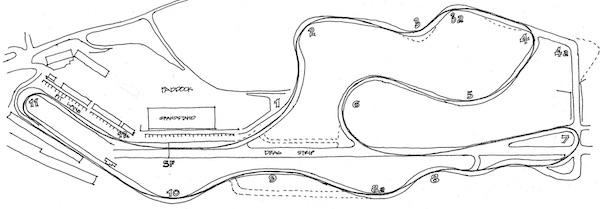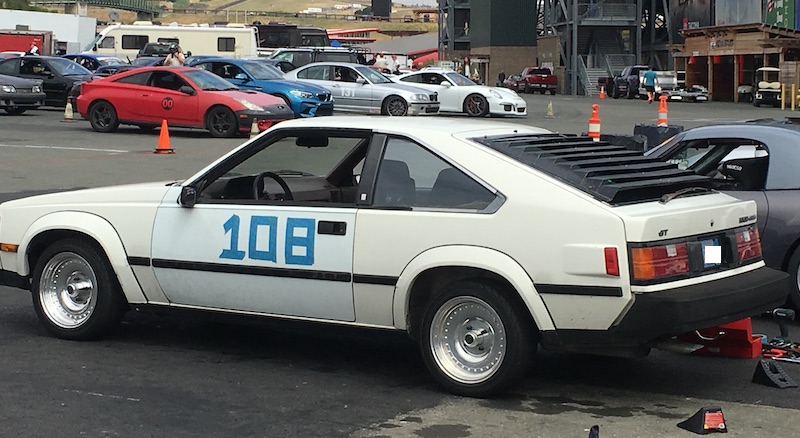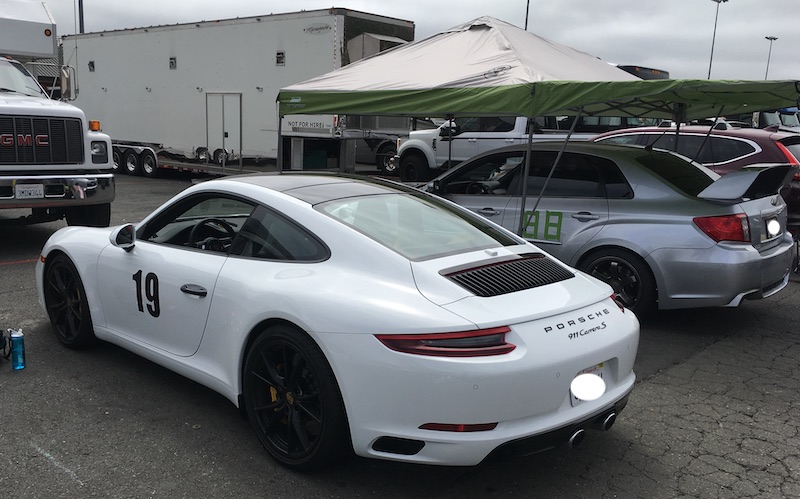Second Track Day! Sonoma, NASA Norcal
16 Jun 2019 [getting-started] [sonoma] [nasa-norcal]
This was my second high performance driving event, first time at Sonoma Raceway and first time with NASA Norcal. It was a great track, great program and great people. In this post I’ll talk about getting around and what to expect from the track and NASA.
Sonoma Raceway

The NASA schedule pdf that was emailed out as part of registration included parking assignments by group. Since it was a crowded day they asked everyone to park 2 deep in their group, this isn’t a problem since groups all goto grid together.
NASA requires a tech inspection for any vehicle that is > 10 years old or has any modifications. As my car is bone stock and newer than 10 years old I filled out the tech form myself. Just to be sure I walked over to the tech station and confirmed with the guys there. All I had to do was put the form I filled out on my windshield underneath my wiper blade. When I first got to grid they pulled the form and gave my car a tech sticker. It is highly recommended to just have tech done before the event at one of the approved shops to avoid delays on the track day.
Driver’s meeting
All drivers across all groups met in the Driver’s Lounge. This is labelled and just past the cafe as you come into the parking area. Pretty straight forward intro then they called out where drivers in what groups should meet where. Group 1 was staying in the room. Three instructors led a discussion around how to interpret the flags, how to behave on track and other basics. Once this was covered students names were called out and matched with instructors, everyone split out with their instructor at this point.
Meeting with instructor
Met with the instructor and went over objectives for the day and my previous experience at Thunderhill the week prior. I wanted to focus on getting the line down, situational awareness of flag stations and other cars. I less interested with going fast today. I also wanted to focus on consistency. Both the NASA and HOD training sessions talked about driving at 7/10ths of you and your car’s capability. This margin of safety gives you some room should you accidently get into an unexpected situation. This is also where consistency comes in. As a novice driver on the track you might have +/- 4 of your limit which if you think you’re at 7/10 you might be at 11 and lose control. By focusing on consistency and slowing down a bit I’ll be able to raise 7/10th up to 9/10th over time as I improve. After reviewing the flags again and print outs of the track we split up to meet later during group 1’s first time out.

First Laps
First time out is just slow and waving to the flag stations, I was the only one really waving but don’t worry just wave away. The goal here is awareness of the flag stations. Instructor was also calling out how to scan visually as you enter and exit turns. For example when you’re coming through turn 9 you can also see if there are any flags at the finish flag station.
Downloads
The downloads (after session debrief with other drivers and instructors) with NASA were also very good. The safety team from the track gives a list of issues and the instructors give everyone a chance to volunteer if they think they are on the list, its a good system.
New driver loses control
One of the drivers in our group on the second session spun out into the wall on turn 11. You could tell he was stressed about it but the discussion during the download was constructive and helpful for all drivers to understand how it happened and how to avoid it in the future. The driver who spun out didn’t miss a session and graduated to group 2 later on in the day. The cause of the accident was coming into apex of turn 11 with too much speed and on the throttle. Realizing they were too fast the driver abrutly took their foot completely off the gas while in the turn. This abrubt control input immediately shifts weight forward as there is no acceleration and the engine is now actually braking slightly. With the weight moving foward the rear tires lost traction and unhooked from the road, a condition known as snap oversteer. The car came to a rest with the passenger rear bumper crushed up against the wall coming out of turn 11. Yellow flags came out at the flag station leading into turn 11 and everyone got past the accident without issue.
“When in a spin, both feet in”
When you lose control you are supposed to push the clutch all the way in along with the breaks while keeping the steering wheel straight. This causes your car to act predictable to other drivers and you will spin around less and hopefully come to a stop before you hit something. It’s something I practiced a few times with the car parked / engine off just to get the feel for it should I need to in the moment.
Working on specific turns

Group 3 is in grid behind.
Turn 8 climbs into a crest that is blind to turn 8a. You need to position your car ahead of time to track it out nicely and this took some practice to get right. “Tracking out” refers to using the entire track and getting your wheels out of the track. There is usually a red/white striped curb that you’re trying to use up.
Turn 3 is another climb into a blind crest for 3a that you need to set your car up ahead of time for. As you crest these turns your control input is limited as your car starts to “fly” since the momentum is going upwards. My instructor was very specific around wanting to have the car lined up towards the entry of turn 4 before you crest turn 3a. This was especially important in my rear engine vehicle as coming in not straight with limited traction and then trying to adjust with all the weight in the rear is not possible.
Turn 7 has a “false” entry point, you see a striped curb but that is for a different track configuration, you ignore this. Instead you track out at a yellow line then cut in to a curb. This took me a few times to internalize not cutting in early.
Turn 11 is tight, you take it wide then apex at the 2nd to last stack of tires and exit as close to the driver’s left wall as you feel comfortable.
Passing in Group 1/2
Passing rules for NASA group 1/2 differ from HOD substantially. In HOD they have cone marked sections of the track where you are allowed to pass IF the driver you are passing gives you a “point by”. I describe this protocol in more detail in my first track day post. With NASA you are allowed to pass in any straight section without the driver ahead of you indicating you should do so. The driver being passed should maintain the line while the driver passing goes off line.
For the most part drivers were respectful but one driver was consistently powering past several cars at a time aggressively. During a download this behavior was discussed and the driver was combative with the instruction staff. The staff handled it well, asked everyone to take a deep breath and they would talk about it one on one. That driver wasn’t seen again the rest of the day.
It’s important to make sure you have enough space to pass and if you’re being passed lift off the gas to allow the pass to complete safely. I slowed to allow one driver to pass me on the straight coming into turn 7 and he attempted to pass myself as well as the car ahead of me. The passing car entered turn 7 ahead of both of us but overshot and lost the backend. Seeing he was coming in too hot I had slowed way down, the car ahead of me turned in tighter and passed him in the turn. He regained control and proceeded ahead of me and we exited the turn.
Passenger in a Spec Miata for a Time Trial session
I manged to link up with a car broker I had worked with who races spec miata. If you’re not familiar a spec class is a verify specific car/equipment setup so you’re racing against similar vehicles. In this case we were doing a time trial run and it was very cool to see how fast the TT group runs compared to our novice group =)
Passing is unlimited and people are moving very fast VERY close to each other, definitely looking forward to getting my skills up to participate at that level!
Crashes
There was a professional event occuring alongside us the Trans Am series presented by Pirelli. During one of their runs a vehicle dumped oil up the hill from turn 1 to turn 2. This is already a challenging turn and caused 6 cars to lose control and crash into the wall of turn 2. We were in grid for the time trial session while this was happening so we sat for quite a while as they pulled damaged cars off the track.
During the time trial run a car in Spec 350Z lost control on the exit of turn 6. The accident was critical enough that the driver was removed via ambulance and black flags came out ending the session. The driver was ok, the car, not so much.
Other thoughts

The STI is also in Group 1
I checked my tire pressure throughout the day this time and bled them once to keep them in spec. I also ordered brake pad and tire tread measuring tools. I intend to measure before and after the track day going forward so I have an idea of when I need to change tires or brake pads.
I also think that I may look into a more basic vehicle to learn on until my skills improve. My 911 is definitely more capable than I am at the moment. I think a less powerful car would allow me to skill up faster. Focusing on consistency during the day paid off as my instructor signed me off for Group 2 after the second to last run. I ran solo on the last run and it was definitely cool to be on my own! I grid up behind a white STI and she just took off, almost lapped me as I saw her in my rear view only 3 cars back when the checkered flag came out. I definitely have a lot of work to do!
If this post was useful or you have questions around other areas let me know via email, driver at durandal * org